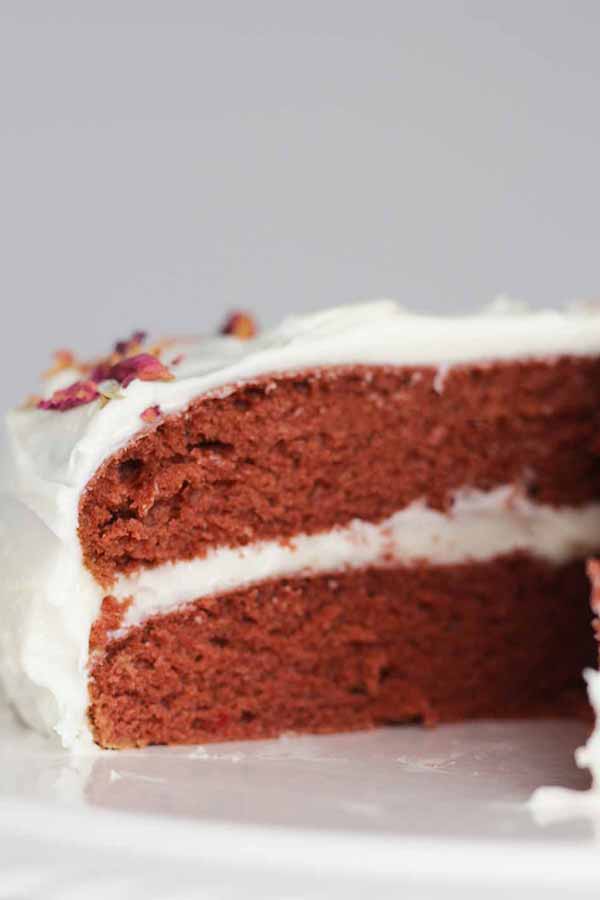Plain Flour vs Self-Raising Flour: What’s The Difference?
Flour is a white, powdery food that is made by grinding down raw cereal grains such as wheat. It’s a versatile kitchen ingredient that can be used for all types of cooking and baking, for things like cakes, bread, muffins, croissants and more. There are many types of flour, including plain flour, self-raising flour, pastry flour and cake flour. But what’s the difference between plain flour vs self-raising flour? Are they the same thing? Let’s find out!

Can vegans eat flour?
Since this is a vegan baking blog, I thought I’d start with the question, ‘can vegans eat flour?’ and the answer is yes. Flour is a vegan-friendly ingredient and is not made using any animal products or byproducts. It can be used in a number of vegan baking recipes like cakes, cookies, pancakes, brownies shortbread and fruit crumble. It can also be used for savoury vegan recipes such as bread, crepes and pasta.
Plain Flour vs All Purpose Flour
Is plain flour the same as all purpose flour? People often ask what’s the difference between the two but the answer is that they are both the same thing. It’s not a case of plain flour vs all-purpose flour but rather just two different names for the same thing.
All-purpose flour is the name that is often used in North America. In the UK, we prefer to call it plain flour. If you look around the baking aisle in the supermarket here, you will only see flour labelled as ‘plain’.
I was a little confused between the difference between plain flour and all purpose flour at first so don’t worry if you didn’t know- now you do!
All about plain (all-purpose) flour
Plain flour is just that- plain! Flour is made up of wheat (ground up into a flour), and fortifying vitamins such as calcium carbonate, iron, thiamin and niacin. These vitamins must be added to all brown and white flour in the UK, in accordance with the Bread and Flour regulations (yes, this is a thing). These are added to make the flour more nutrient dense. All of the vitamins added to UK flour are vegan-friendly, and you’ll see the vegan label marked on most brands.
Plain or all purpose flour is usually used to make savoury baked goods, or sweet goods that have a more dense texture. It’s what gives things like pizza dough, cookies, and pastry their structure.
What can you use instead of flour to thicken?
Plain flour can also be used to thicken soups, sauces and stews. But if you don’t have any to hand, what can you use instead?
- Cornflour. Can you use cornflour instead of flour to thicken sauces? You sure can! In fact, sometimes it can do a better job and it’s a great gluten-free plain flour alternative! Many people also ask if you can use cornflour instead of plain flour for baked goods but the answer is usually no. A gluten-free blend such as Dove’s farm will work much better. If you use cornflour instead of plain flour for something like a cake, it would be gummy and dense. It’s best to just stick to thickening if replacing flour with cornflour.
- Potato starch. Potato starch is another great alternative to flour to thicken sauces and other liquid-y foods. It works similarly to cornflour.
- Tapioca starch. Similar to using cornflour instead of flour, tapioca works best when you mix it with a small amount of cold water first. This will prevent it from clumping at higher temperatures.
- White rice flour. This is another great flour alternative for thickening. Again, if you want to use a gluten-free flour alternative for baking, it’s best to use a gluten-free plain flour blend.
Cake recipes with plain flour
As noted above, there are many different ways you can use plain flour or all-purpose flour. But if you’d like to know how to use plain flour in baking, why not try out one of these cake recipes ideas:
- Lemon drizzle cake
- Biscoff cake
- Victoria sponge can be made with plain flour just be sure to add 2 teaspoons of baking powder to this recipe!
Plain flour cups to grams conversion
If you’ve found a recipe you really want to try but are not sure about the cups to grams measurements, you can use this handy table to help you out. Please note that using cups is not as accurate and therefore the recipe may not turn out exactly as you expect. For best accuracy, I’d recommend converting cups to grams, rather than the other way around. Gram measurements below have been rounded to the nearest number.
| Cups Plain flour | Grams Plain flour |
| 1/8 cup | 16g |
| 1/4 cup | 31g |
| 1/3 cup | 42g |
| 1/2 cup | 63g |
| 2/3 cup | 83g |
| 3/4 cup | 94g |
| 1 cup | 125g |
| 2 cups | 250g |
You can use the cup values above to calculate any other amounts that you need. For example, if the recipe calls for 1+1/8 cups, simply add 1 cup (125g) + 1/8 cup (15g) together. 1+1/8 cups is equal to 140g of plain flour. Some other common quantities are listed below:
- 150g of plain flour in cups is 1+1/4 cups.
- 225g of plain flour in cups is 1+3/4 cups.
- 300g of plain flour in cups is 2+3/8 cups
- 500g of plain flour in cups is 4 cups
Can I use plain flour instead of self-raising?
What can I use instead of self-raising flour, I hear you ask? You can use plain flour as a replacement for self-raising flour…as long as you add extra raising agents.
Here’s a quick tip on how to make self-raising flour. Add 1 teaspoon of baking powder per 1 cup (125g) of plain flour and mix together. Then add this as instructed in your recipe, instead of self-raising flour. In most recipes, 2-3 teaspoons of baking powder will usually suffice.
Plain Flour vs Self-Raising Flour: How are they different?
The only difference between plain flour and self-raising flour is that self-raising flour already has the raising agent added to it. This is more convenient for some people as it saves the need to buy the baking powder separately.
The downside to using self-raising flour would be if you don’t bake very often, the raising agent in it may lose it’s rising power over time. In this instance, you may be better off using plain flour because you can ensure your baking powder is fresh when you get around to using it. If you’re a regular baker however, self-raising flour or self-rising flour is a more convenient and cheaper option.

All about self-raising flour
As noted above, self-raising flour is essentially plain flour with raising agents added to it already. It’s also known as self-rising flour in some other parts of the world.
Self-raising flour is often used in baking, to make light, fluffy goods such as cakes, muffins, cupcakes, scones and pancakes. You usually wouldn’t use self-raising flour for things like brownies, crumble, shortbread or other baked goods that don’t need any lifting power.
Can you use self-raising flour instead of all-purpose flour?
This depends on the recipe. If your recipe contains baking powder or baking soda, it’s generally OK to use all-purpose flour instead of self-raising flour, as long as you omit the extra baking powder/soda.
If the recipe does not contain baking powder or soda, or if it’s for something like a brownie, I wouldn’t recommend replacing self-raising flour with plain flour. If you were to use self-raising flour in brownies, you’d end up with something more similar to a chocolate cake due to the airiness the raising agents give.
Can you make shortcrust pastry with self-raising flour?
It’s not recommended to use self-raising flour for pastry. Shortcrust pastry tends to rise as it bakes in the oven, even when you use plain flour, so using self-raising flour will likely misshape it.
Cake recipes using self-raising flour
If you want to use self-raising flour in a cake recipe, try one of the tasty treats linked below:
Self-raising flour cups to grams
As you’ll see below, the conversion is the exact same for self-raising flour vs plain flour. They’re both white flour so they weigh the same. Again, I have rounded to the nearest gram for ease.
| Cups Self-raising flour | Grams Self-raising flour |
| 1/8 cup | 16g |
| 1/4 cup | 31g |
| 1/3 cup | 42g |
| 1/2 cup | 63g |
| 2/3 cup | 83g |
| 3/4 cup | 94g |
| 1 cup | 125g |
| 2 cups | 250g |
Here are some other common quantities for self-raising flour cups to grams. Please note these are estimates- I recommend using a food scale for accuracy.
- 225g of self-raising flour is 1+3/4 cups
- 275g of self-raising flour is 2+1/4 cup
- 300 of self-raising flour is 2+3/8 cups
- 500g of self-raising flour is 4 cups

I hope this post helped to explain the difference between plain flour and self-raising flour! Leave a comment to let me know what you’re baking next! xo



